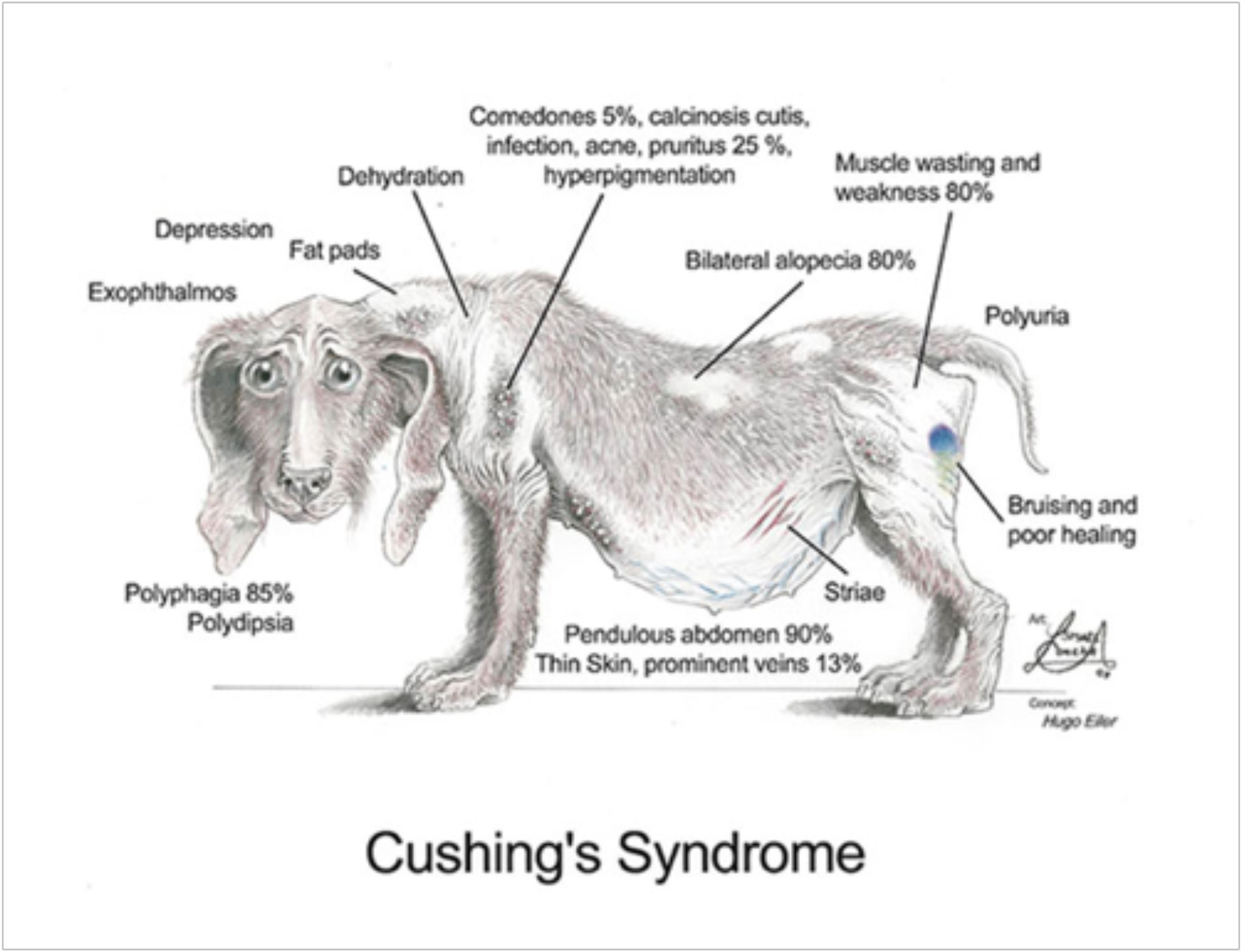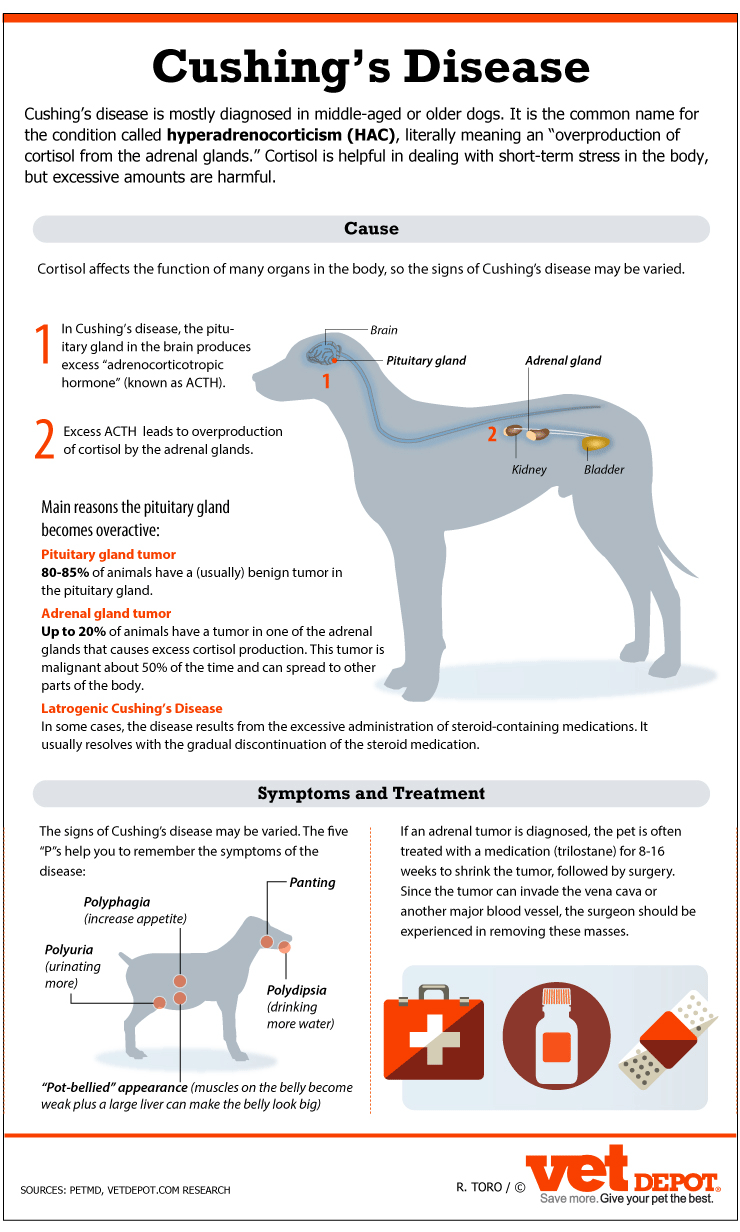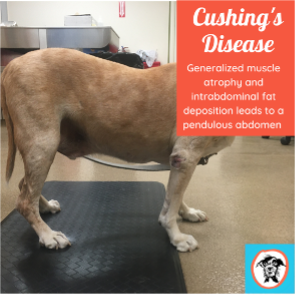To test for Cushing’s disease in dogs, veterinarians typically use a combination of blood tests, urine tests, and imaging studies to diagnose the condition accurately. Diagnosis may involve a low-dose dexamethasone suppression test or an ACTH stimulation test to measure cortisol levels and identify the presence of the disease.
If you notice symptoms such as excessive thirst, urination, or weight gain in your dog, it’s essential to consult a veterinarian for proper testing and diagnosis. Cushing’s disease, also known as hyperadrenocorticism, can significantly impact a dog’s health and quality of life.
Understanding the diagnostic process is vital for dog owners to ensure early detection and proper management of the condition. By staying informed about the testing methods for Cushing’s disease, pet owners can work proactively with their veterinarians to provide the best possible care for their furry companions. Regular check-ups and timely testing can help identify and address Cushing’s disease promptly, leading to better outcomes for dogs.

Credit: www.newenglandvetservices.com.au
What Is Cushing’s Disease In Dogs?
What is Cushing’s Disease in Dogs?
Cushing’s Disease, also known as hyperadrenocorticism, is a condition that affects dogs’ endocrine system. It occurs when the adrenal glands, located near the kidneys, produce excessive amounts of cortisol hormone. Cortisol is crucial for regulating the body’s response to stress, but too much of it can have harmful effects on a dog’s overall health.
Causes Of Cushing’s Disease
Cushing’s Disease in dogs can have different causes, each leading to an excessive production of cortisol. The most common cause is a benign tumor called pituitary-dependent hyperadrenocorticism (PDH). In this case, the pituitary gland, which controls hormone production, releases excess adrenocorticotropic hormone (ACTH), stimulating the adrenal glands to produce more cortisol.
Another cause of Cushing’s Disease is adrenal-dependent hyperadrenocorticism (ADH), which occurs when there is a tumor present in one or both of the adrenal glands. These tumors can be either benign or malignant and can independently produce cortisol, causing an imbalance in the body.
Symptoms Of Cushing’s Disease
Identifying the symptoms of Cushing’s Disease in dogs is essential for early detection and treatment. Some common symptoms include:
- Increased thirst and urination
- Persistent hunger and weight gain
- Enlarged abdomen
- Thinning of the skin
- Poor wound healing
- Muscle weakness
- Loss of hair
- Irritability or behavioral changes
If you notice these symptoms in your furry friend, consulting a veterinarian is crucial to confirm a Cushing’s Disease diagnosis. Early detection and proper treatment can significantly improve your dog’s quality of life.

Credit: www.vetdepot.com
Diagnostic Tests For Cushing’s Disease
When diagnosing Cushing’s disease in dogs, several diagnostic tests are used to determine the presence of the condition. The most common diagnostic tests for Cushing’s disease in dogs include physical examination, blood tests, urine tests, and imaging tests. Each of these tests plays a crucial role in diagnosing the disease and guiding the treatment plan.
Physical Examination
A physical examination is the first step in diagnosing Cushing’s disease in dogs. The veterinarian will look for common symptoms such as hair loss, skin changes, and excessive thirst. They will also assess the dog’s overall health and look for any abnormalities that may indicate Cushing’s disease.
Blood Tests
Blood tests are essential for diagnosing Cushing’s disease in dogs. The most common blood test used is the low-dose dexamethasone suppression test. This test measures the levels of cortisol in the dog’s blood before and after receiving a low dose of dexamethasone, a synthetic corticosteroid. Elevated cortisol levels after the test indicate the presence of Cushing’s disease.
Urine Tests
Urine tests are also used to diagnose Cushing’s disease in dogs. The most common urine test is the urine cortisol-to-creatinine ratio test. This test measures the ratio of cortisol to creatinine in the dog’s urine, which can help determine if the dog has Cushing’s disease.
Imaging Tests
Imaging tests such as ultrasound and radiography may be used to identify tumors in the adrenal glands or pituitary gland, which can be an indication of Cushing’s disease in dogs. These imaging tests can help veterinarians determine the underlying cause of the disease and develop an appropriate treatment plan for the dog.
How To Interpret Test Results
When testing for Cushing’s disease in dogs, it’s crucial to accurately interpret the test results. Understanding the normal range for hormone levels and distinguishing between pituitary and adrenal Cushing’s disease are essential for proper diagnosis and treatment. Let’s explore how to interpret test results to effectively identify Cushing’s disease in dogs.
Normal Range For Hormone Levels
An important factor in interpreting test results for Cushing’s disease in dogs is knowing the normal range for hormone levels. These levels can vary based on the specific hormones being evaluated, but generally, cortisol levels should fall within the range of 1 to 4 μg/dL when measured in the morning for dogs.
Identifying Pituitary Cushing’s Disease
When analyzing test results, identifying pituitary Cushing’s disease involves assessing the ratio of various hormones. A high ACTH (adrenocorticotropic hormone) to low cortisol ratio commonly indicates pituitary-dependent Cushing’s disease in dogs. Notably, this imbalance in hormone levels is a key indicator for differentiating pituitary Cushing’s disease from adrenal Cushing’s disease.
Identifying Adrenal Cushing’s Disease
In contrast, adrenal Cushing’s disease can be identified by high cortisol levels, as well as low ACTH levels. This presentation of hormone levels points towards an adrenal tumor as the cause of Cushing’s disease in dogs. By understanding these hormone level patterns, veterinarians can accurately distinguish adrenal Cushing’s disease from other potential causes.
Additional Tests And Consultations
Cushing’s disease in dogs can be diagnosed through additional tests and consultations with a veterinarian. These tests may include blood work, urine analysis, imaging tests, and hormonal tests to determine the presence of the disease. Consulting with a veterinarian is crucial in order to properly test and diagnose Cushing’s disease in dogs.
Low-dose Dexamethasone Suppression Test
The Low-Dose Dexamethasone Suppression Test is a reliable diagnostic tool used to detect Cushing’s disease in dogs. This test involves administering a low dose of dexamethasone, a synthetic steroid, to the dog and then measuring the cortisol levels in their blood. Cortisol is a hormone that is typically higher in dogs with Cushing’s disease.
During the test, blood samples are taken before the administration of dexamethasone and then at specific intervals afterward, usually at 4 and 8 hours. These samples are analyzed to determine if the cortisol levels have been sufficiently suppressed by the low dose of dexamethasone.
If the dog’s cortisol levels remain high or show only minimal suppression, it could indicate the presence of Cushing’s disease. Further tests may be required to confirm the diagnosis and determine the underlying cause of the condition.
High-dose Dexamethasone Suppression Test
In cases where the Low-Dose Dexamethasone Suppression Test does not provide conclusive results, a High-Dose Dexamethasone Suppression Test may be performed. This test follows a similar procedure but involves administering a higher dose of dexamethasone to the dog.
The goal of the High-Dose Dexamethasone Suppression Test is to provide a more significant suppression of cortisol levels. If the dog’s cortisol levels remain elevated or only show minimal suppression even with the higher dosage, it could indicate the presence of Cushing’s disease.
It’s important to note that the High-Dose Dexamethasone Suppression Test may not always be necessary and is typically used when the results from the Low-Dose Test do not provide a conclusive diagnosis.
Acth Stimulation Test
The ACTH Stimulation Test is another diagnostic tool used to test for Cushing’s disease in dogs. This test works by measuring the dog’s cortisol levels before and after the administration of synthetic adrenocorticotropic hormone (ACTH).
During the test, a baseline blood sample is taken to measure the dog’s cortisol levels. Then, a dose of synthetic ACTH is administered, usually via an injection, and additional blood samples are taken at specific time intervals afterward, typically at 1 and 2 hours.
The cortisol levels in these post-ACTH blood samples are analyzed to determine the response of the dog’s adrenal glands. In dogs with Cushing’s disease, the cortisol levels typically remain high or fail to suppress adequately after the administration of ACTH.
Consulting With An Endocrinologist
If your dog has been diagnosed with Cushing’s disease or if further testing is required, it’s essential to consult with an endocrinologist, a specialist in hormonal disorders.
Endocrinologists have in-depth knowledge and experience in diagnosing and managing hormonal disorders, including Cushing’s disease. They can help interpret test results, determine the best treatment options, and provide guidance throughout the management process.
Working closely with an endocrinologist allows for a comprehensive and tailored approach to your dog’s healthcare, ensuring the most effective diagnosis and treatment strategies are employed.
Treatment Options For Cushing’s Disease
Learn about the testing methods and treatment options available for diagnosing and managing Cushing’s disease in dogs. Discover how veterinarians can accurately diagnose this condition through various tests, including blood and urine analysis, imaging exams, and hormone stimulation tests.
Medication
Cushing’s disease in dogs can be managed through various treatment options. One of the commonly used methods is medication. Medications such as trilostane and mitotane are often prescribed to control the overproduction of cortisol hormone in dogs with Cushing’s disease.
The primary goal of these medications is to regulate the cortisol levels and alleviate the symptoms associated with the condition. Trilostane works by inhibiting the enzymes responsible for cortisol production, while mitotane decreases the cortisol production by affecting the adrenal glands.
It is important to note that these medications should only be administered under the supervision of a veterinarian. Regular monitoring of your dog’s cortisol levels and overall health is crucial to ensure the medication is effectively managing the disease.
Surgical Intervention
In some cases, surgical intervention may be considered as a treatment option for Cushing’s disease in dogs. One possible surgical procedure is the removal of adrenal gland tumors, which are often the cause of the disease.
Adrenalectomy, the surgical removal of one or both adrenal glands, aims to eliminate the source of excessive cortisol production. However, this procedure is invasive and requires highly skilled veterinarians.
Surgery may not be suitable for all dogs, especially if there are complications or if the tumor has spread. Prior diagnostic tests and evaluations are typically necessary to determine if your dog is a good candidate for surgical intervention.
Lifestyle Changes
In addition to medication and surgery, making certain lifestyle changes can support the management of Cushing’s disease in dogs. These changes primarily focus on providing your dog with a healthy and balanced lifestyle.
Regular exercise is crucial, as it helps to maintain your dog’s overall health and weight. Remember to consult with your veterinarian before implementing any exercise routine, as excessive exercise or strenuous activities may not be suitable for dogs with Cushing’s disease.
Diet plays a significant role in managing the symptoms of Cushing’s disease. Feeding your dog a balanced and nutritious diet can help control weight gain and minimize complications. Consult with your veterinarian to determine the most appropriate diet plan for your dog’s specific needs.
Lastly, providing a stress-free environment for your dog can help reduce cortisol levels. Minimizing loud noises, sudden changes, and other potential stressors can contribute to your dog’s overall well-being.

Credit: vetgirlontherun.com
Frequently Asked Questions For How To Test For Cushing’s Disease In Dogs
Can Cushing’s Disease In Dogs Be Cured?
Cushing’s disease in dogs can be managed and symptoms can be
controlled with the help of medication and regular veterinary care. However, it is not considered to be completely curable at this time.
How Is Cushing’s Disease Diagnosed In Dogs?
To diagnose Cushing’s disease in dogs, veterinarians usually perform
a series of tests including blood tests, urine tests, and imaging studies
such as ultrasounds or X-rays. These tests help to identify the presence
of abnormal hormone levels and any underlying tumors.
What Are The Common Symptoms Of Cushing’s Disease In Dogs?
Common symptoms of Cushing’s disease in dogs include increased thirst
and urination, weight gain, excessive appetite, hair loss, potbelly
appearance, lethargy, and recurring skin infections. It’s important to
consult with a veterinarian if these symptoms are noticed in a dog.
Is Cushing’s Disease Fatal For Dogs?
Cushing’s disease itself is not usually fatal for dogs, but if left untreated,
it can lead to a variety of serious health complications. These complications
may include conditions such as diabetes, liver disease, and weakened
immune system, which can ultimately reduce a dog’s lifespan.
Conclusion
Testing for Cushing’s disease in dogs is essential for early diagnosis and effective treatment. By being aware of the common symptoms and utilizing the appropriate diagnostic tests, pet owners can ensure the well-being of their furry companions. Regular check-ups with a veterinarian, along with a thorough understanding of the disease, can significantly improve the quality of life for dogs affected by Cushing’s disease.
Stay proactive and attentive to your dog’s health to provide them with the care they deserve.


